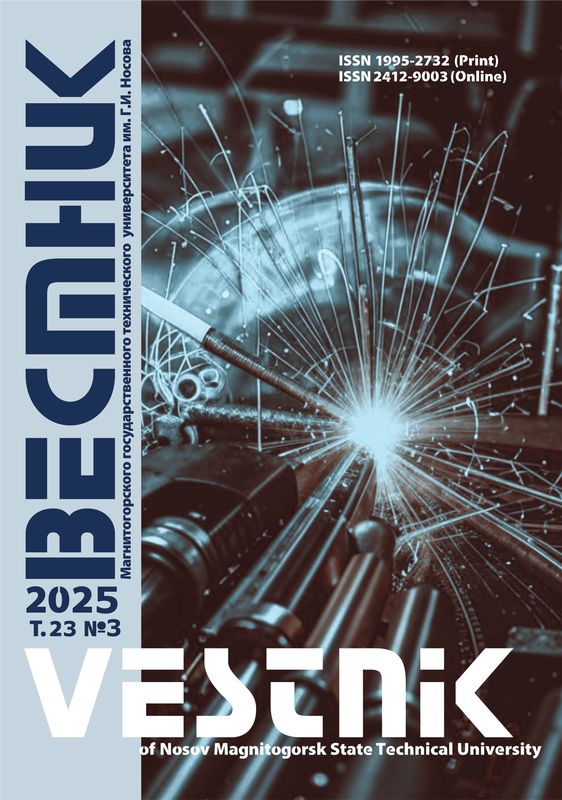DOI: 10.18503/1995-2732-2023-21-3-78-88
Abstract
The paper presents a comparative analysis of the use of rheological models with 5 and 9 coefficients based on the Hensel-Spittel empirical formula. The material under study is a new aluminum alloy, RS-356 (Al – 92.58; Si – 6.83; Mg – 0.29; Mn – 0.002; Fe – 0.14; Ti – 0.15; Cu – 0.002; Zn – 0.003), workpieces from which are formed by selective laser melting. The values of the unknown coefficients were determined by carrying out full-scale and computational experiments, namely a method for solving the inverse problem, as well as using an original method for processing the results of the full-scale experiment. The full-scale experiment was carried out by testing cylindrical specimens of alloy RS-356 under study for compression in the temperature range from 20 to 450 ℃ at constant strain rates of 0.001, 0.01 and 0.4 s-1. The specimens with a diameter of 10 mm and a height of 10 mm were produced by electroerosion from workpieces of the RS-356 alloy. The computational experiment was carried out using the QFORM software package; values of unknown coefficients in rheological models – applying Matlab software. Accuracy of the values of the coefficients in each of the obtained models is estimated by coefficient of determination R2. So, regarding a model with 9 coefficients, R2 = (0.95-0.97) depending on the temperature interval. The established dependencies with 9 coefficients for describing the rheological properties of RS-356 provide accuracy of predicting force parameters, when modeling the plastic deformation process within 5% and can be used in computer modeling of metal forming operations for a temperature range of 20-450 ℃ and strain rates of 0.001, 0.01 and 0.4 s-1.
Keywords
RS-356 aluminum alloy, compression test, Hensel-Spittel rheological model, yield curve, deformation stress model
For citation
Vo Phan Thanh Dat, Petrov P.A., Burlakov I.A., Pham Van Ngoc, Nguyen Khanh Toan, Gnevashev A.A. Obtaining Rheological Models of Aluminum Alloy RS-356 under Various Deformation Modes. Vestnik Magnitogorskogo Gosudarstvennogo Tekhnicheskogo Universiteta im. G.I. Nosova [Vestnik of Nosov Magnitogorsk State Technical University]. 2023, vol. 21, no. 3, pp. 78-88. https://doi.org/10.18503/1995-2732-2023-21-3-78-88
1. Belyaev A.I., Bochvar O.S., Buinov N.N. et al. Metallovedenie alyuminiya i ego splavov: Sprav. izd. [Metal science of aluminum and its alloys: Reference book]. Moscow: Metallurgy, 1983, 280 p. (In Russ.)
2. Tusar R.S., Ramanuj K., Isham P., Ashok K.S., Amlana P., Rabin K.D. Machinability behavior of Aluminium Alloys: A Brief Study. Materials of Today: Conference Proceedings. 2019;18:5069-5075.
3. Petrov P.A., Khanh Nguyen Toan, Burlakov I.A., Sukhorukov R.Yu. Control of forming processes of titanium alloy blanks (using OT4-1 alloy as an example) using rheology modeling and deformation modes. Problemy mashinostroeniya i nadezhnosti mashin [Problems of Mechanical Engineering and Reliability of Machines]. 2021;(6):88-95. (In Russ.) DOI: 10.31857/S0235711921060134
4. Szeliga D., Gaward E., Pietrzyk M. Inverse analysis for identification of rheological and friction models in metal forming. Computer Methods in Applied Mechanics and Engineering. 2006;195:6778-6798.
5. Smirnov A.S. Razrabotka metodiki identifikatsii opredelyayushchikh sootnosheniy dlya metallov pri bolshikh vysokotemperaturnykh plasticheskikh deformatsiyakh: dis. … kand. tekhn. nauk [Development of a technique for identifying constitutive relations for metals at high high-temperature plastic deformations. PhD thesis]. Yekaterinburg, 2008. 243 p.
6. Liye Liang, Xuexin Pan, Guilan Wang, Haiou Zhang, Hao Zhang. Microstructure and mechanical properties of the molten AlSi7Mg selective laser. Journal of Physics: Conference Series. 2021;1939;012041.
7. Charpentier P.L., Stone B.C., Ernst S.C., Thomas J.R. Characterization and modelling of high temperature flow behavior of aluminum alloy 2024. Met.Trans. A. 1986;17:2227.
8. Petrov P.A. A method for evaluation of the flow stress under two-stage monotonic loading. Izvestiya Tulskogo gosudarstvennogo universiteta. Tekhnicheskie nauki [Izvestiya of Tula State University. Engineering Sciences]. 2019;(5):157-174. (In Russ.)
9. Petrov P.A., Pham Ngoc Van, Burlakov I.A., Matveev A.G., Saprykin B.Yu., Petrov M.A., Vo Phan Thanh Dat. Building yield curves of aluminum alloy RS-356 based on a full-scale and computational experiment. Tekhnologiya legkikh splavov [Technology of Light Alloys]. 2023;(1):63-69. (In Russ.)
10. Zyuzin V.I., Brovman M.Ya., Melnikov A.F. Soprotivlenie deformatsii staley pri goryachey prokatke [Deformation stress of steels during hot rolling]. Moscow: Metallurgy, 1964, 270 p. (In Russ.)
11. Hensel A., Shpittel T. Raschet energosilovykh parametrov v protsessakh obrabotki davleniem: spravochnik [Calculation of force parameters in metal forming processes: Handbook]. Moscow: Metallurgy, 1982, 360 p. (In Russ.)
12. Marquardt D.V. An algorithm for least-squares estimation of nonlinear parameters. Journal of the Society of Industrial and Applied Mathematics. 1963;11(2): 431-441.












